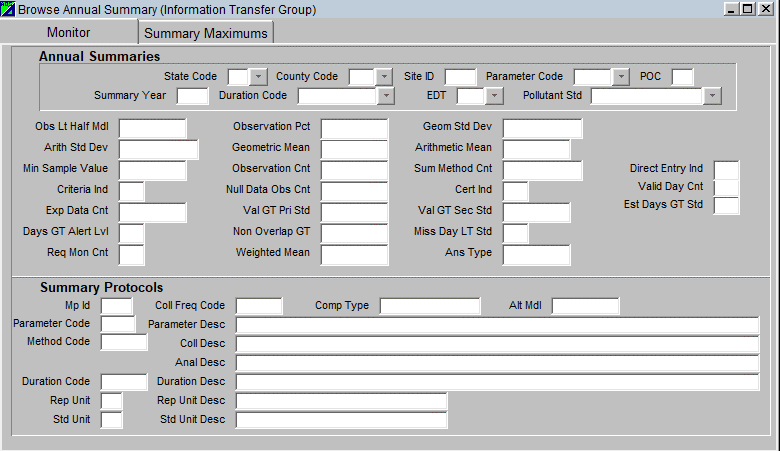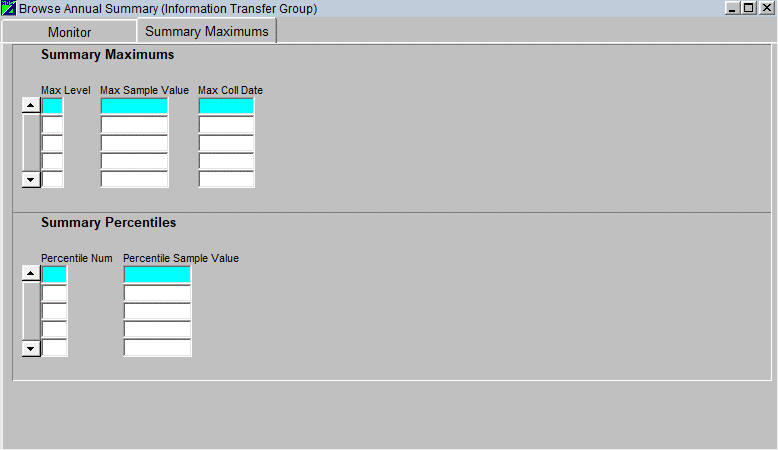Batch Submission of Data - Type of Data in AQS
On this page:
- Site data
- Monitor data
- Ambient Air Quality data
- Quality assurance data
- Summary data
- Production level data
- Annual summary
Type of Data in AQS
Site Data
Site information refers to the geographical location where monitoring occurs. This includes the following types of information: latitude and longitude coordinates, what geopolitical entities at location (e.g. county, city, EPA Region, etc), local site name, and street address. Information about nearby roads is also stored with the site information.
[Note] Site location, site address and lat/long coordinates, is required so that operators and auditors have accurate directions to the site.
Identified by:
AQS generally list site IDs in the following way: SS-CCC-NNNN
SS is the State FIPS (Federal Information Processing Standards) Code, CCC is the County FIPS Code, and NNNN is the Site Number within the county.
[Note] leading zeros are always included
Example: 01-089-0014, Alabama, Madison County, Site Number 14.
Tribal site IDs do not list state and county. They are listed in the following way: TT-BBB-NNNN
TT is the two capital Ts to denote Tribal, BBB is the BIA (Bureau of Indian Affairs) Tribal code, and NNNN is the Site Number within the tribal lands.
Example: TT-007-7002, Tribal, St. Regis Band of Mohawk Indians of New York, Site Number 7002.
Required Group
Locational data is required and the AQS system will only accept Latitude/Longitude values.
Monitor Data
For the purposes of AQS, a monitor does not refer to a specific piece of equipment. Instead, it reflects that a given pollutant (or other parameter) is being measured at a given site. Monitor description information covers several different types of information about how the monitor is configured.
Such as: When was the monitor operational? How high is the probe? Where is the probe located? How close is this monitor to the highway? What monitoring networks does it belong to? What is the objective of this monitor? Who owns and operates this monitor?
Identified by:
The site where the monitor is located, the pollutant code, and POC (Parameter Occurrence Code), which is used to uniquely identify a monitor if there is more than one device measuring the same pollutant at the same site.
For example, monitor IDs are usually written in the following way: SS-CCC-NNNN-PPPPP-Q, which is the Site ID plus, PPPPP being the AQS 5-digit parameter code and Q is the POC.
For example: 01-089-0014-44201-2: Alabama, Madison County, Site Number 14, Ozone monitor, POC 2.
Ambient Air Quality Data
Raw data, also called sample data, is by far the most abundant data in the database. The raw data are the individual ambient air quality measurements from the monitors.
Identified by:
The monitor where the measurement was taken and the time when the sample was taken.
Quality Assurance Data
Quality Assurance (QA) data consists of the set of audits that are utilized to verify that the measurement uncertainty (error) associated with the sample measurements (raw data) is within acceptable limits. For the regulatory pollutants, the process is defined by Title 40 of the Code of Federal Regulations, Part 58, Appendix A. Other specialized programs, such as the Chemical Speciation Network (CSN) have their own QA requirements. AQS supports a set of QA transactions for submitting this information.
Identified by:
The monitor or lab where the quality check was taken and the date-time of the check.
Summary Data
All of the data is submitted to AQS for one primary purpose: to determine the exposure of populations to certain pollutants. Since most of the health-related measurements are couched averages of various time lengths, the system creates multiple levels of summaries of the raw data. The data is summarized on a daily, quarterly, and annual basis. Additionally, if there is a national standard for pollutant with a special averaging time (such as a running 8-hour average for example), the system will create these summarized averages as well.
Transaction Formats
The first field of all input formats is the transaction type, i.e., "RD", which indicates the type of data in the record. The second field is the Action Indicator, i.e. "I" for insert, "U" for update, and "D" for delete, which indicates the requested database manipulation action. The next block of fields is the primary key information which usually includes the State Code (or Tribal Indicator), County Code (or Tribal Code), Site ID, Parameter, and POC. It may also include assessment type or agency identifier. The combination of key fields serves to uniquely identify the record. Valid transaction types can be found at: https://aqs.epa.gov/aqsweb/documents/TransactionFormats.html
Data Codes
Data codes and related user documentation can be found in the AQS Data Coding Manual. The AQS Data Coding Manual is house on the AQS website: https://www.epa.gov/aqs.
Production Level Data
Browse
There are five Browse functions, found under the Retrieval section of the Menu Bar. Each of them provides the user with read-only access to specific production level data related to the specific form. The user has the option to select a limited range of data on each of the forms by selecting specific query filters, which vary from form to form. The five Browse Forms are:
- Annual Summary
- Approved Regional Methods
- Sample Methodology
- Parameters
- Standard Reports
Annual Summary
The Browse Annual Summary form, found under the Retrieval section of the Menu Bar, gives the user the ability to query and browse through production-level Annual Summary Data. The user can limit the data retrieved by entering selection criteria on the form. The available criteria are displayed on the form under two different tabs:
Annual Summary

Summary Maximums

